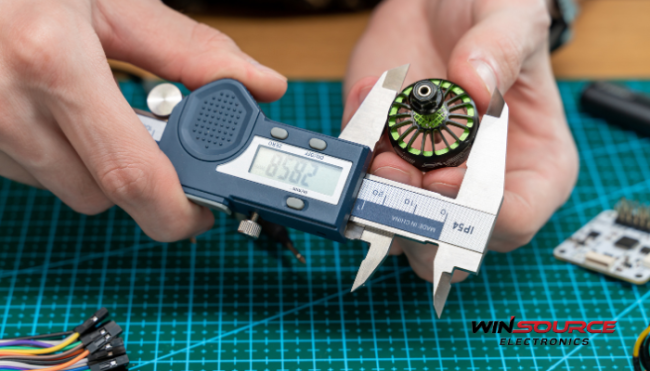
* Question
What is the circuit of the capacitance micrometer?
* Answer
A capacitance micrometer is a device used to measure small distances, displacements, or thicknesses by utilizing the principle of capacitance. The basic idea is to measure the change in capacitance as the distance between two capacitor plates (one typically fixed and the other movable) changes. Here’s an overview of the typical circuit and components involved in a capacitance micrometer:
Basic Concept:
The capacitance C between two plates is given by the formula:
C=ε0εrA/d
Where:
-ε0 is the permittivity of free space,
-εr is the relative permittivity of the dielectric material between the plates,
– A is the area of overlap of the plates,
– d is the distance between the plates.
As the distance between the plates changes (due to displacement), the capacitance changes, and this change can be used to measure the displacement.
Key Components:
1. Capacitor Plates: These form the basic sensing element. One plate is typically fixed, while the other is movable, depending on the displacement to be measured.
2. Oscillator Circuit: This is used to convert the small changes in capacitance into a measurable signal. An RC (Resistor-Capacitor) or LC Inductor-Capacitor oscillator is commonly used.
3. Demodulator/Detector: The oscillation signal is processed and converted into a voltage proportional to the capacitance change.
4. Microprocessor or Analog Circuit: This can be used to convert the voltage signal into a displacement value and display it on a digital or analog readout.
5. Display (Digital/Analog): To show the measured displacement or thickness.
Circuit Diagram Overview:
Here’s a simplified explanation of the circuit involved:
1. Capacitance Sensor
– Two parallel plates are placed with one fixed and the other moving with respect to the object whose displacement is to be measured. The capacitance changes as the distance between these plates changes.
2. Oscillator Circuit
– An oscillator circuit is often used to convert the varying capacitance into a measurable signal. A typical choice would be an LC oscillator (using an inductor and the capacitance sensor as part of the LC circuit) or an RC oscillator (using a resistor and capacitor).
For example, in an LC oscillator:
– The capacitor formed by the sensor is part of an LC resonant circuit. The oscillation frequency of the circuit depends on the value of the capacitor. As the capacitance changes due to the movement of the sensor plates, the frequency of oscillation also changes.
Alternatively, in an RC oscillator:
– The capacitance of the sensor is combined with a fixed resistor to form an RC timing circuit. The time constant of the circuit will change as the capacitance changes, leading to a change in the output signal.
3. Frequency-to-Voltage Conversion
– If an oscillator is used, a frequency-to-voltage converter (such as a frequency counter or phase-locked loop (PLL)) is used to convert the frequency change into a proportional voltage.
– Alternatively, if an analog capacitance-to-voltage method is used, the signal from the sensor can be directly amplified and processed using an operational amplifier (op-amp) circuit, with the output voltage being proportional to the capacitance change.
4. Signal Processing and Display
– The processed signal is fed to a microcontroller or analog circuitry that converts the signal into a displacement reading.
– The reading is then displayed on a digital display (such as an LCD or LED display) or an analog meter to show the measured value.
Example Circuit Components:
– Oscillator: An LC oscillator circuit using the capacitance sensor as part of the LC tank circuit.
– Frequency-to-Voltage Converter: An IC such as the LM2917 can convert frequency into a proportional voltage.
– Amplifier: Operational amplifiers like the OP-AMP or TL081 can be used to amplify small signals.
– Microcontroller: A microcontroller (e.g., Arduino or PIC) can be used for digitizing and processing the signal, providing display control, and perhaps even calibration.
– Display: A 7-segment display or a small LCD screen to show the displacement value.
Basic Steps in the Circuit:
1. Capacitive Sensing: The sensor’s capacitance changes with the displacement.
2. Oscillator: The capacitance affects the frequency of the oscillator.
3. Signal Processing: The frequency signal is converted to a voltage that is proportional to displacement.
4. Display: The voltage signal is displayed as a displacement or thickness measurement.
Example Block Diagram:
1. Capacitance Sensor (Sensing Element):
– Sensing plates that change capacitance with displacement.
2. Oscillator Circuit:
– Frequency proportional to capacitance.
3. Frequency-to-Voltage Converter:
– Converts the frequency change into a voltage.
4. Signal Processing Unit:
– Amplification, filtering, and conversion to a readable value.
5. Display Unit:
– Digital or analog display showing the measurement.
Conclusion:
The capacitance micrometer works by detecting changes in capacitance caused by the movement of a capacitor’s plates. The device usually includes an oscillator circuit whose frequency is proportional to the capacitance. This frequency is then converted into a readable voltage that is displayed on a digital or analog display, providing an accurate measurement of displacement or thickness. The circuit is relatively simple but requires precise components to ensure accurate and stable measurements, especially when measuring small displacements.

COMMENTS